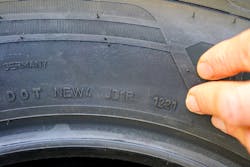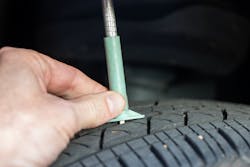Content brought to you by Motor Age. To subscribe click here.
What you will learn:
• Tire safety involves more than just tread depth
• Registering a tire's DOT number is now a requirement
• All-in-one tools exist to aid in tire analysis, documentation and registration
Being in the business of supplying tire service to our customers has always been a profitable venture. Although the margins in tire sales are slim, tire replacement service opens many doors of opportunity for us as technicians and shop owners alike. A simple “flat repair” can allow us to evaluate all the tires’ conditions and perhaps even the opportunity to evaluate the vehicle’s wheel alignment. Of course, that could lead to significant chassis/steering/suspension repairs and adjustments. The benefits are three-fold; a safe vehicle for the motoring public, revenue for the shop, and a fatter payout for the technician.
Gauging tire life
Most of the time, the need for tire replacement is justified by the depth of the remaining tread. The reason should be clear. The surface of the tires provides that critical bond between your vehicle and the road. Because we drive upon a variety of road surfaces and in different weather conditions, tread health and depth are critical components of tire safety; not only for acceleration and handling but also for braking performance. With that beneficial aspect of traction comes the wear or sacrifice of that same surface. Once that tread is no longer sufficient, the traction that was once there will disappear along with it.
Even if only one tire is significantly worn (compared to the others) it’s rare that only that tire is replaced. It’s common to replace them in pairs (at minimum) or as a set of four. Hence the reason tires can be a money-maker.
Measuring the tire tread to determine the remaining usable life is accomplished in a handful of different ways. For years, customers have been instructed to use a penny; inserted head-first, if Abe Lincoln’s head is visible, it’s time for a replacement, as this would indicate the tread depth is less than 2/32” (Figure 1).
Other methods include tools that will not infer tread depth but display it (in millimeters or fractions of an inch). The tread depth gauge is available to the public, is very affordable, and will almost always be found in any technician’s toolbox, regardless of his or her area of expertise (Figure 2). But even without additional tools, the tires include wear indicator bars embedded in the tread to help in determining the need for replacement.
Analyzing the tread wear
Like a doctor can analyze an X-ray (or better yet, a diagnostician analyzing a waveform), the goal is not only to recognize that wear has occurred but to determine the root cause of the wear. If we don't use this approach, we are doing our customers an injustice and are begging for a comeback. Just because a measurement above 2/32” makes the tire legally safe for driving does not make its performance optimal. Tires with lower remaining tread life are prime candidates for experiencing hydroplaning or loss of directional stability. The remaining tread exceeding 6/32” should provide significantly safe performance. However, between 6 and 5/32" should justify considering a replacement for vehicles operating in slicker conditions like snow. Tires between 5 and 4/32" yield a reason for replacement if operating in rainy conditions as their ability to channel water away from the contact surface has been depleted. Tires between 4-3/32" have little useable and safe life left in them and any less tread depth than that comes with a significant loss in performance in handling and breaking in almost any condition.
Everything from improper inflation to worn chassis/suspension components and wheel misalignment can and does contribute to tire wear. Again, fixing the root cause of the wear should be as important as the replacement of the tires themselves.
Times are a-changin'
As time goes on, safety standards have become more stringent across the board. This is evident with the rise of Advanced Driver Assist Systems (ADAS). If the customer didn’t demand all the creature-comfort bells and whistles, the government and the Society of Automotive Engineers sure have.
This tightening of the safety standards is prevalent in the tire industry as well. We as technicians (well, "shops") must register the tires using the number issued to each tire by the Department of Transportation (DOT Number). This number is found on the sidewall of each tire (Figure 3).
The DOT number is comprised of eight to thirteen letters and/or numbers that identify where the tire was manufactured, tire size, and the manufacturer’s code, along with the week and year the tire was manufactured. This information is required to be registered. The reason this becomes so important to us is it provides a means to track the tire for age/years in use, and if any safety recalls were issued concerning the safety of that particular tire.
It goes without saying that if you don’t “cover your tail” you are bound to get bitten. Documentation becomes ever more important today. We are tasked with accurately noting the tires’ DOT number on the repair order, in the shop software, and getting it to the customer (for their records). And information can tend to get misconstrued with the more hands it passes through (we all remember the game “telephone” as kids).
A solution to all this could be as simple as the tool chosen. As I tend to mention in almost every class I conduct or diagnostic article I’ve written, having the appropriate tool to get the job done is only half the benefit. Being familiar with what that tool can do for you is what is required rapidly get your return on investment.
For instance, Autel offers the TBE200 which is a combination of a tire tread depth and brake rotor condition analyzer. Although I’m not one to commercialize any one tool I will say that I’m impressed with the features it boasts because it solves all the challenges mentioned above (Figure 4).
On top of being accurate to within .1mm, the TBE200 tread depth reader provides wear analysis and displays the measurement data curves in real-time, along with service advice for the customer. It also features a means to scan and store the tire DOT number. This device is web-based, so as it is reading the number it can alert you if any recalls on the tire exist (remember the “cover your tail” factor?). During analysis, and if damage to the tire is noticed, pictures can be taken and saved with the tool. But in my opinion, that is not quite the best part.
Optionally, any information that the tool captures can be uploaded to the cloud and anything we would tend to simply document on the repair order can now also be shared both with the shop’s management software and the customer.
This tool can work in tandem with the TPMS tools also offered by Autel (their ITS600). With this combination, all the captured information can be documented in a comprehensive vehicle health report, with the shop information already populating the report. Of course, it allows for printing and physically handing the report to the customer to aid in conversation and education.
Now, other tools on the market may provide some of these same features. The key difference, I think, is having all the features within the same tools that are attractive. But whether or not you are using these tools to aid in efficiency, you certainly don’t need them. They simply make the job faster and easier. Safety should be your number one priority; accuracy is a close second priority. But, in combination with efficiency, it’s a win-win-win combination in my book.
Providing sound information to our customers allows them the opportunity to make sound decisions. Nobody typically likes to learn that they must spend some money, and they certainly don’t care about how much you know until they know how much you care. Alerting them to upcoming investments in their vehicles to keep them safe shows how much you care; they really appreciate that.
About the Author
Brandon Steckler
Technical Editor | Motor Age
Brandon began his career in Northampton County Community College in Bethlehem, Pennsylvania, where he was a student of GM’s Automotive Service Educational program. In 2001, he graduated top of his class and earned the GM Leadership award for his efforts. He later began working as a technician at a Saturn dealership in Reading, Pennsylvania, where he quickly attained Master Technician status. He later transitioned to working with Hondas, where he aggressively worked to attain another Master Technician status.
Always having a passion for a full understanding of system/component functionality, he rapidly earned a reputation for deciphering strange failures at an efficient pace and became known as an information specialist among the staff and peers at the dealership. In search of new challenges, he transitioned away from the dealership and to the independent world, where he specialized in diagnostics and driveability.
Today, he is an instructor with both Carquest Technical Institute and Worldpac Training Institute. Along with beta testing for Automotive Test Solutions, he develops curriculum/submits case studies for educational purposes. Through Steckler Automotive Technical Services, LLC., Brandon also provides telephone and live technical support, as well as private training, for technicians all across the world.
Brandon holds ASE certifications A1-A9 as well as C1 (Service Consultant). He is certified as an Advanced Level Specialist in L1 (Advanced Engine Performance), L2 (Advanced Diesel Engine Performance), L3 (Hybrid/EV Specialist), L4 (ADAS) and xEV-Level 2 (Technician electrical safety).
He contributes weekly to Facebook automotive chat groups, has authored several books and classes, and truly enjoys traveling across the globe to help other technicians attain a level of understanding that will serve them well throughout their careers.




